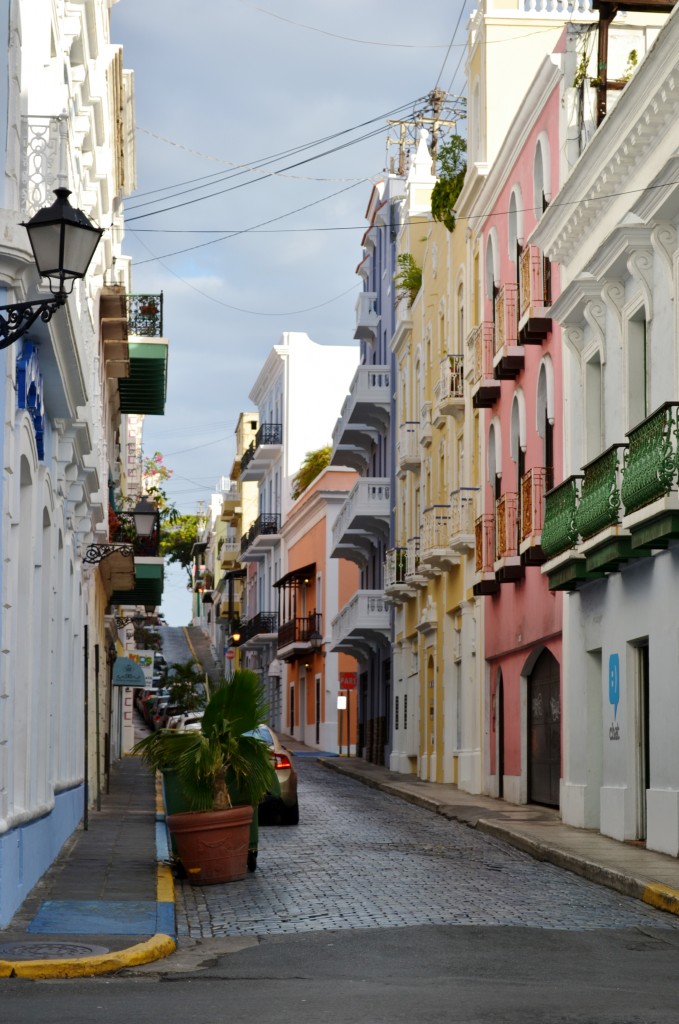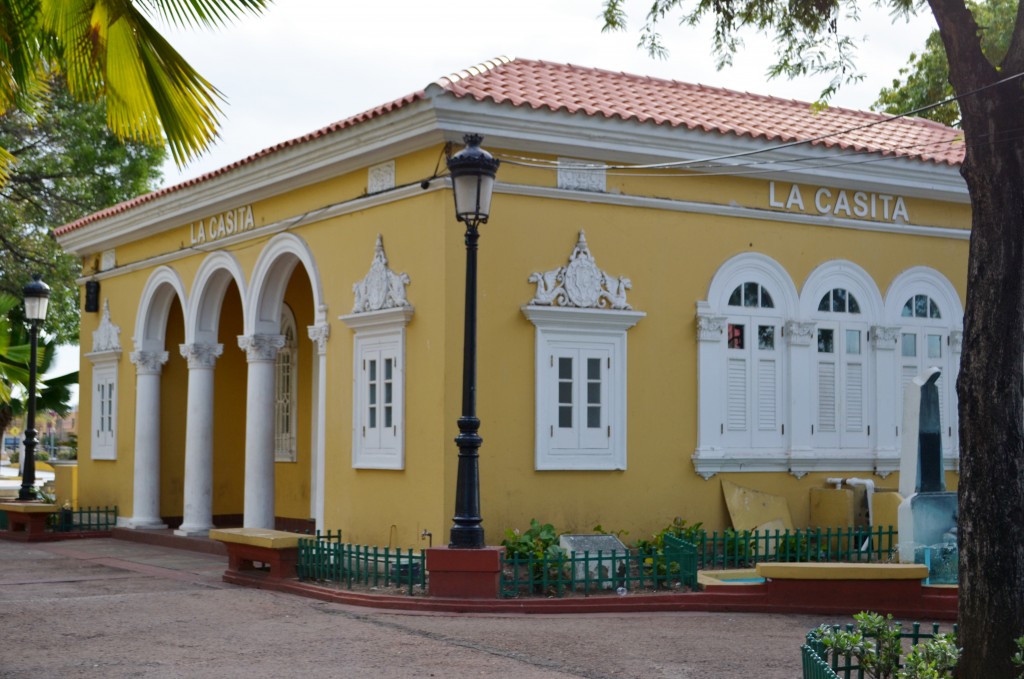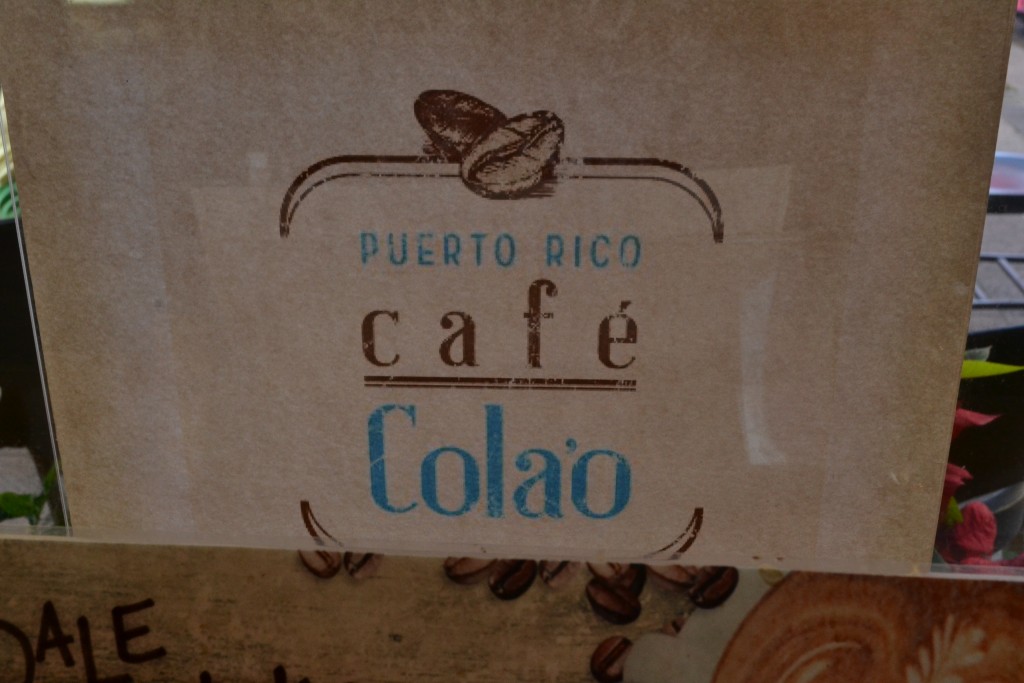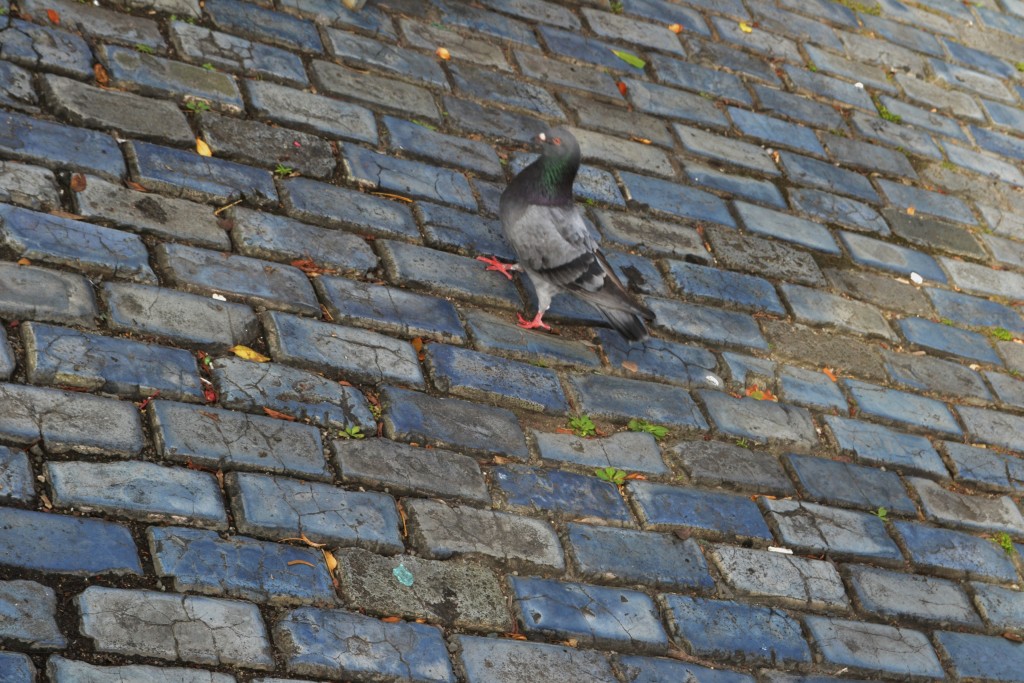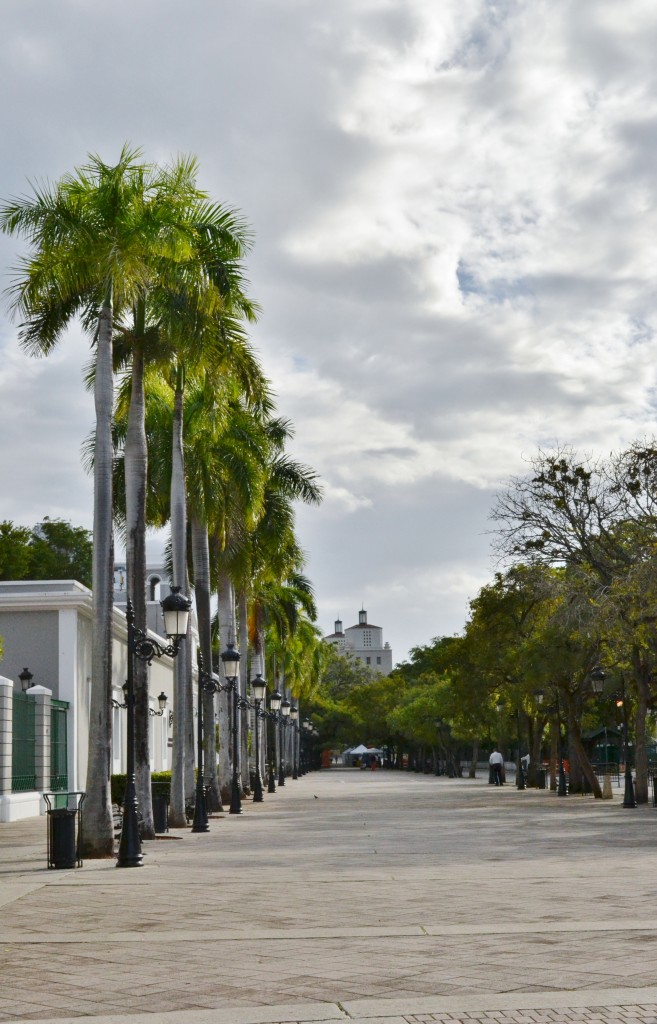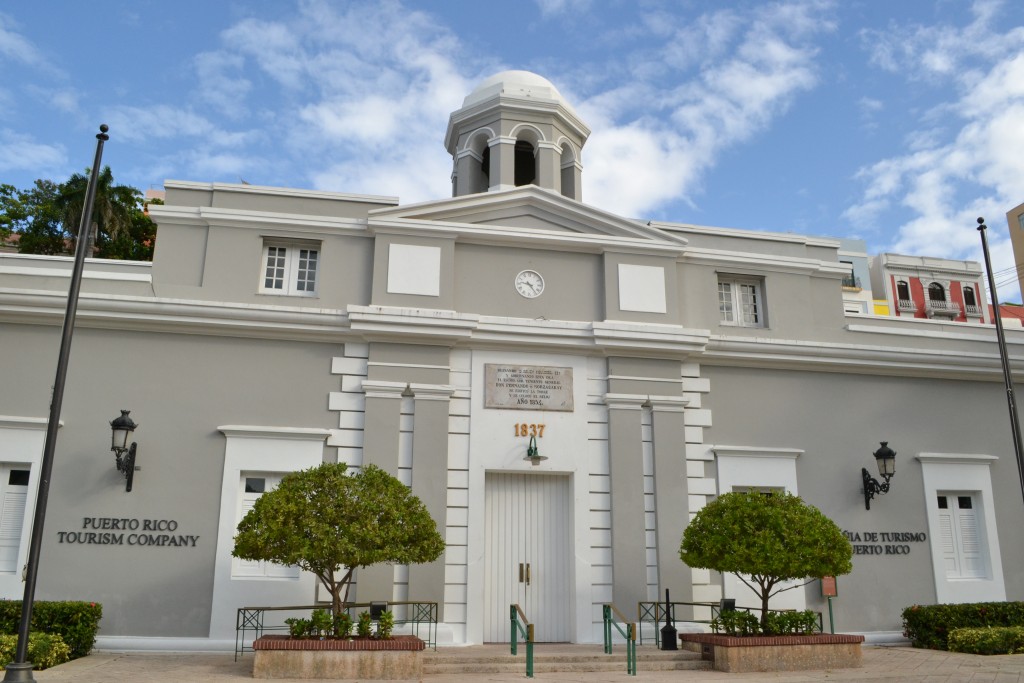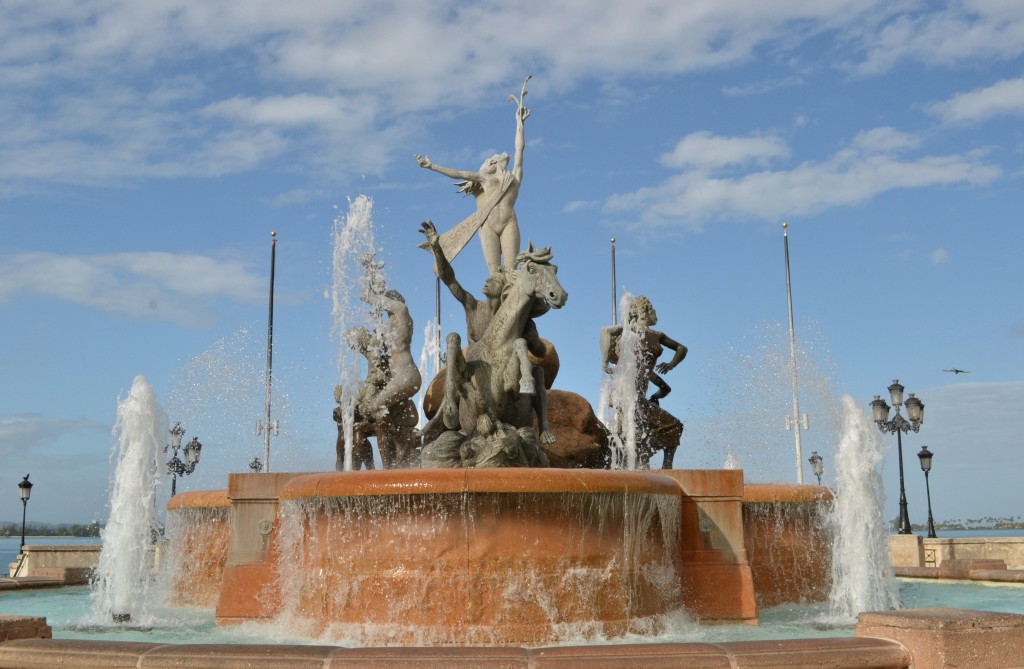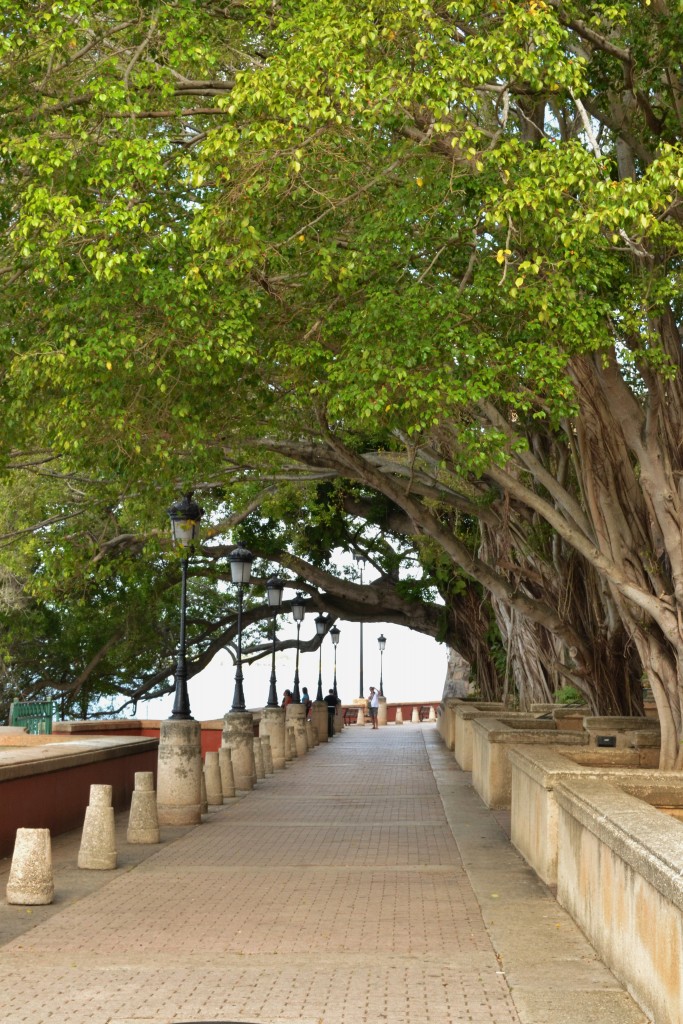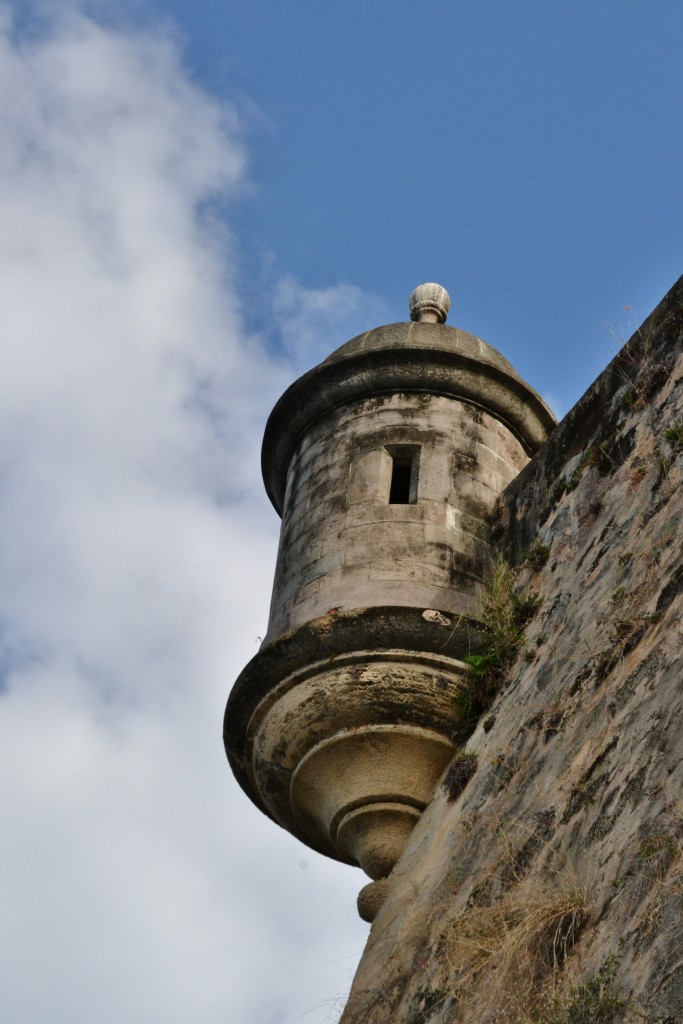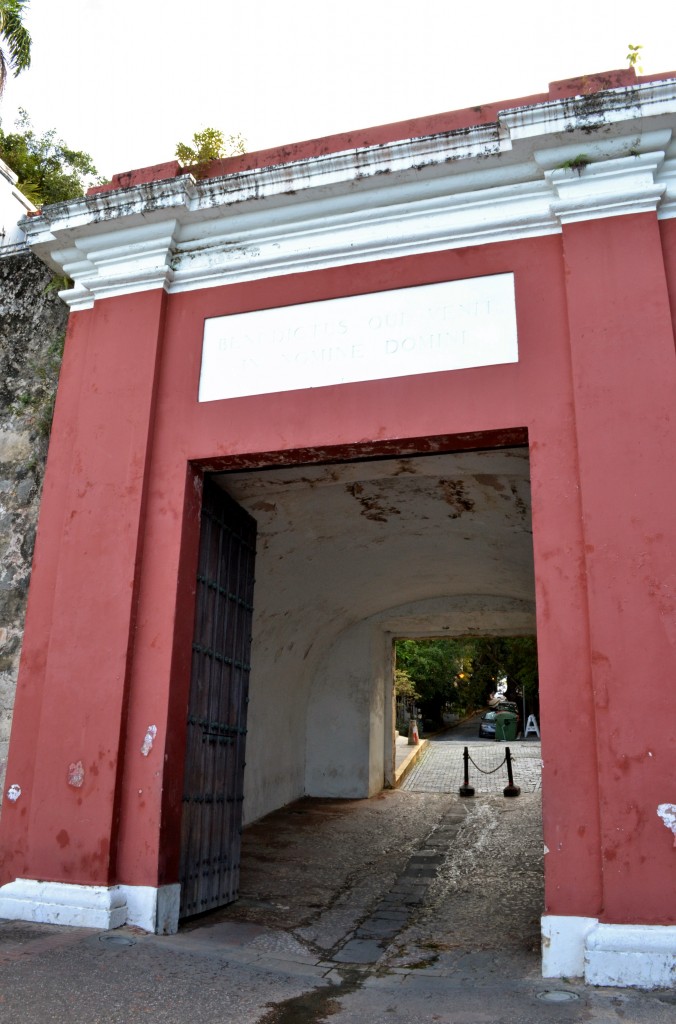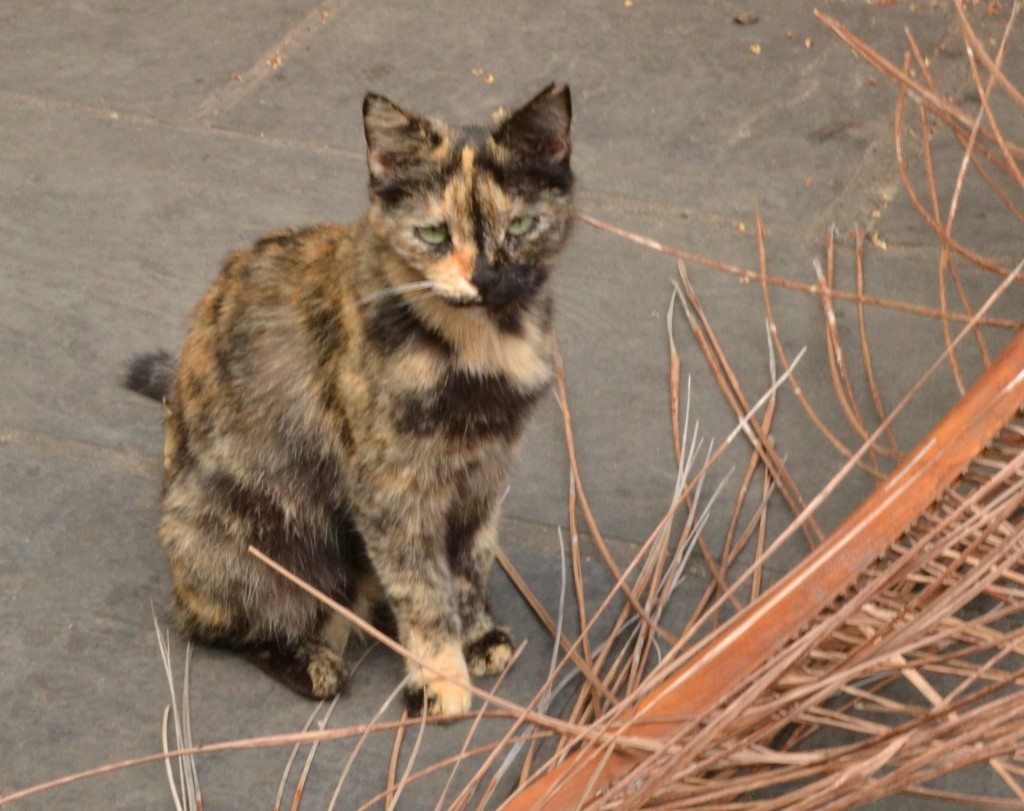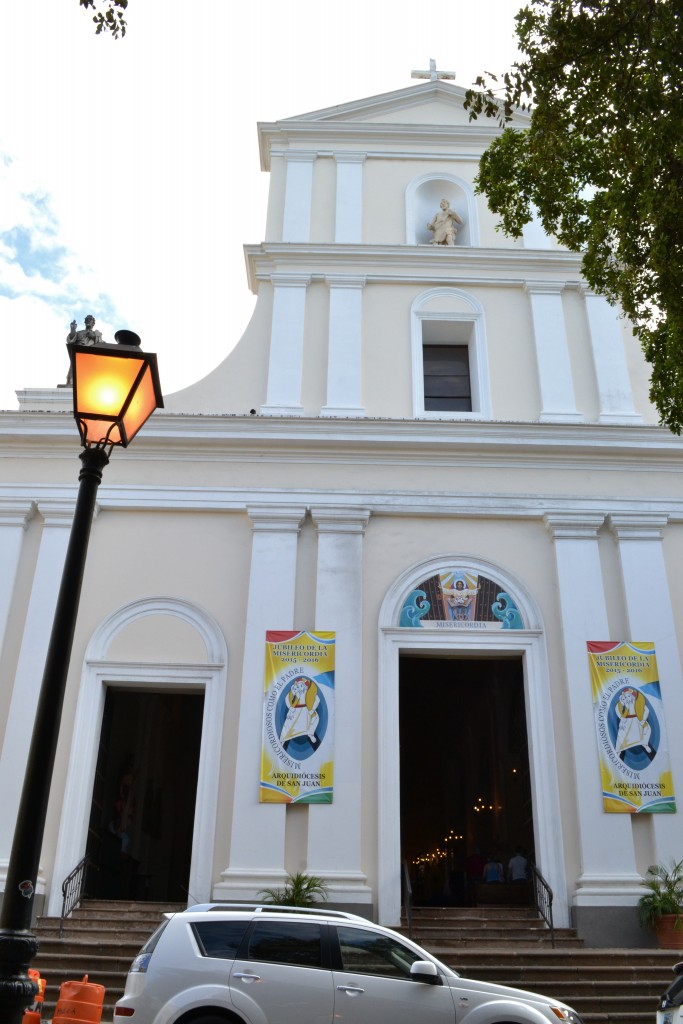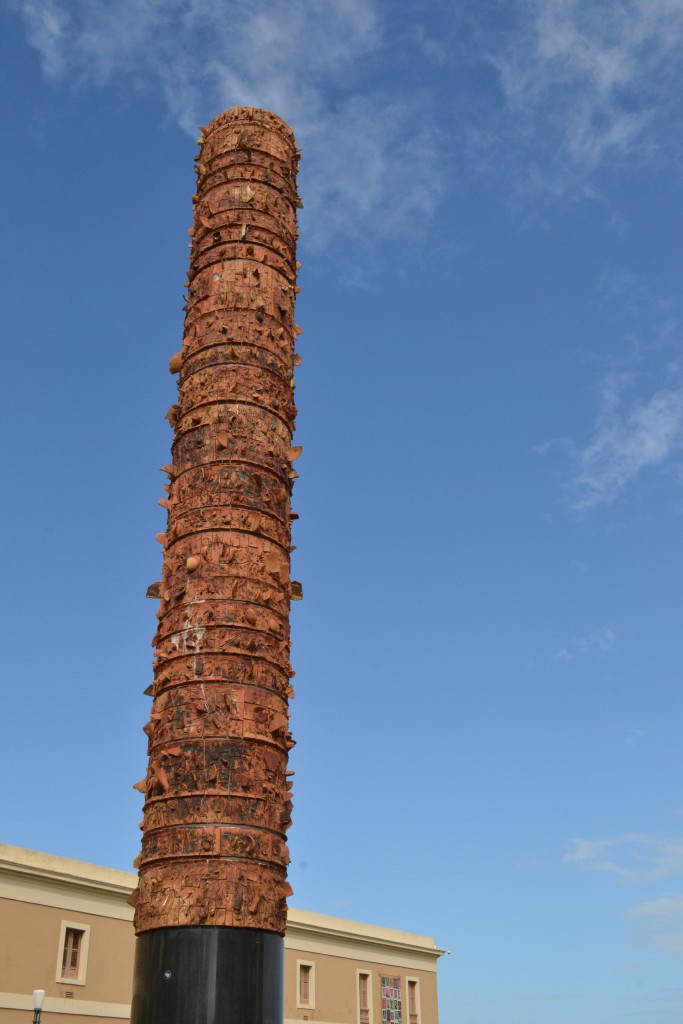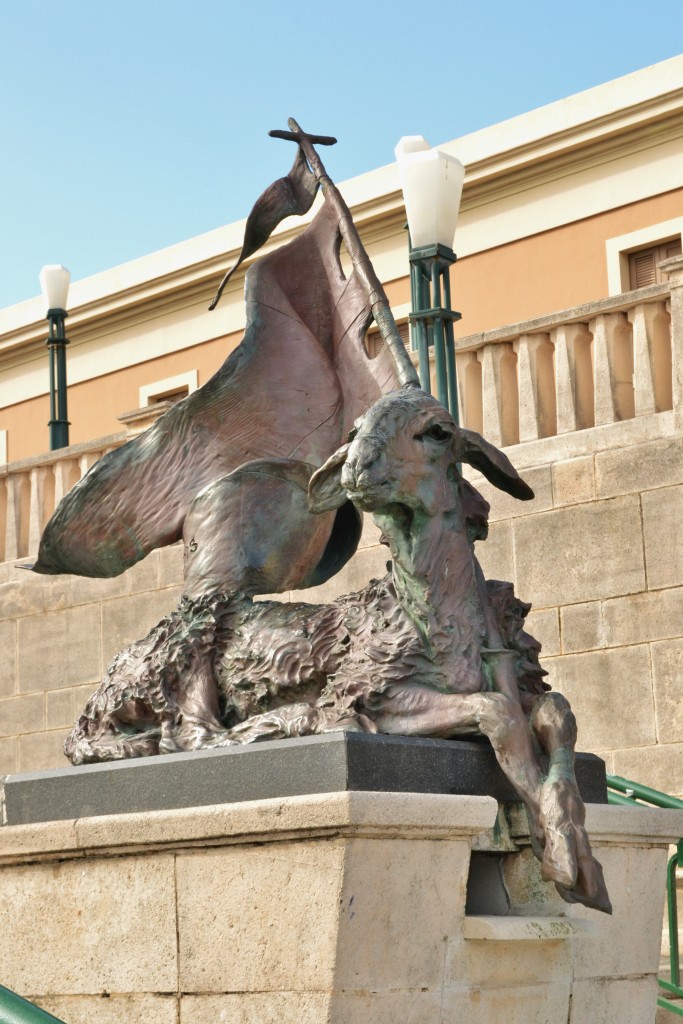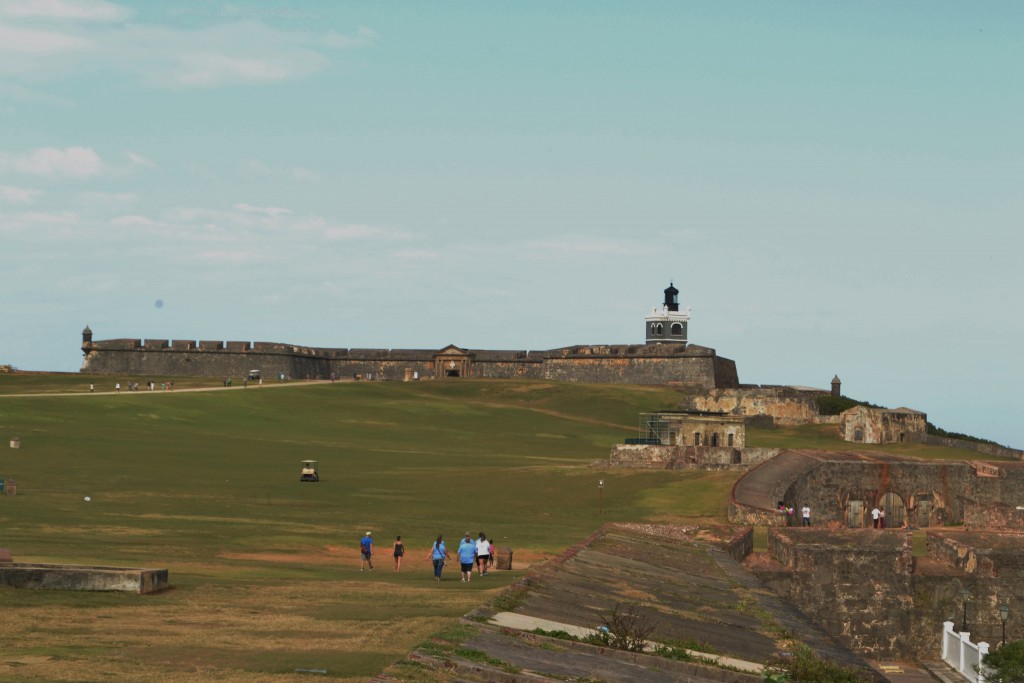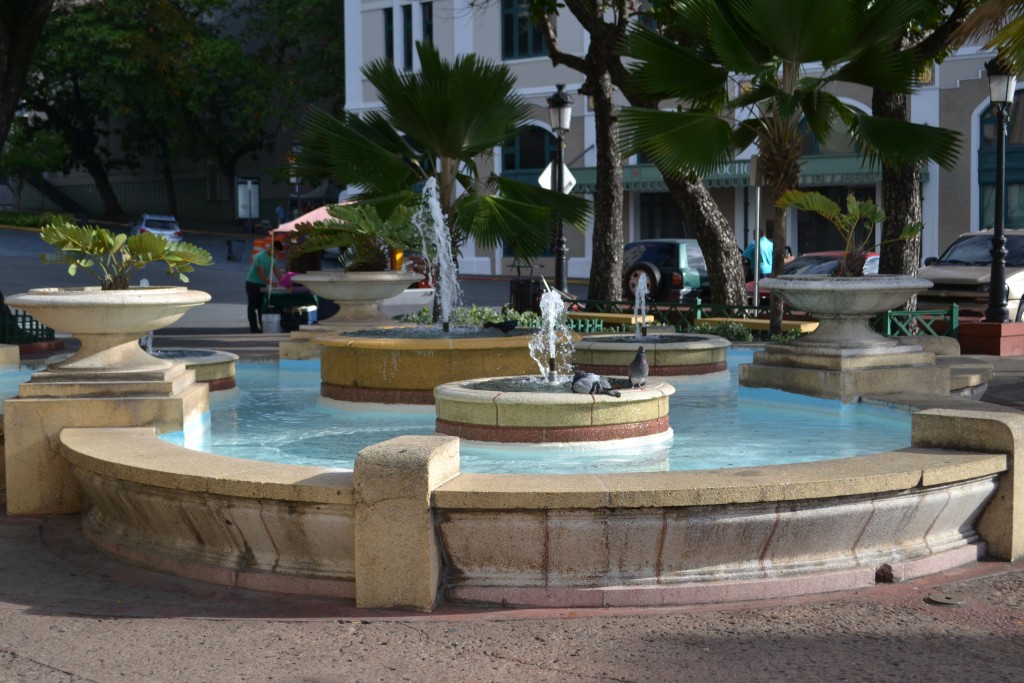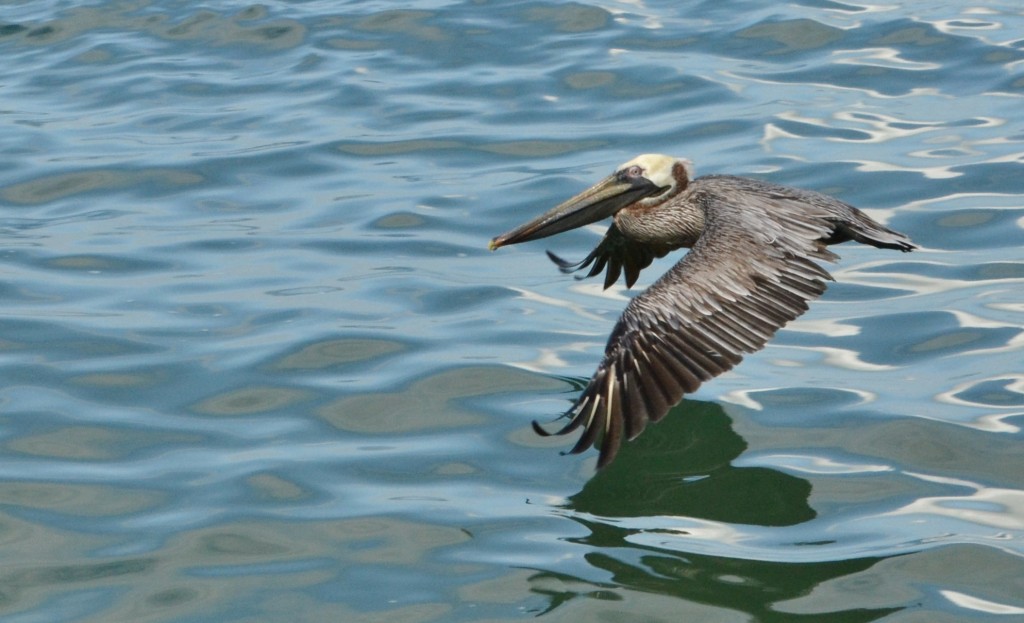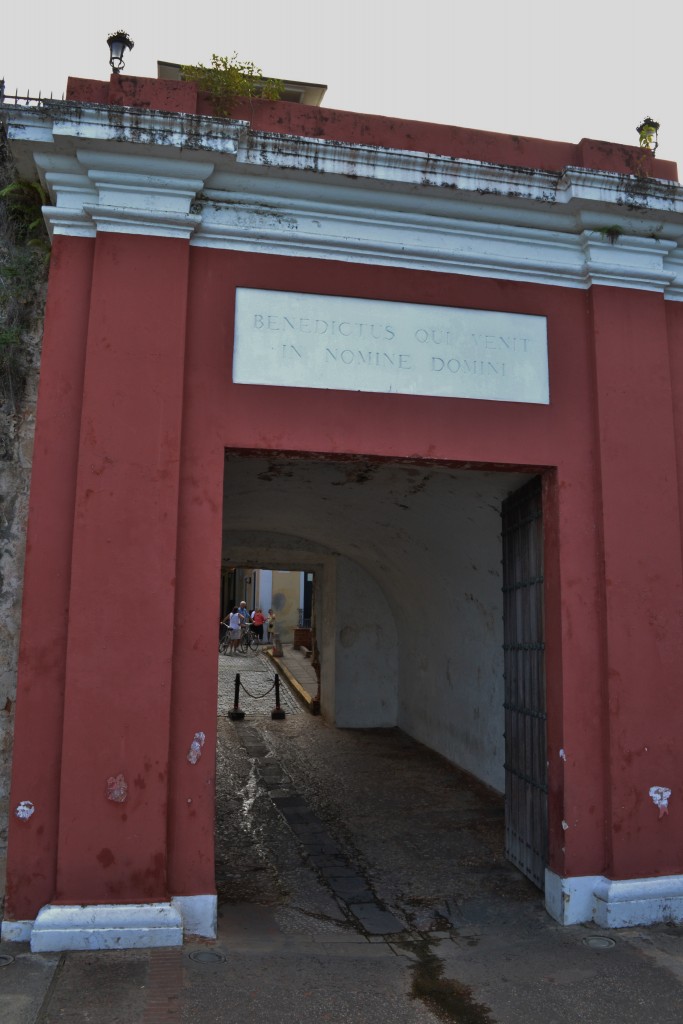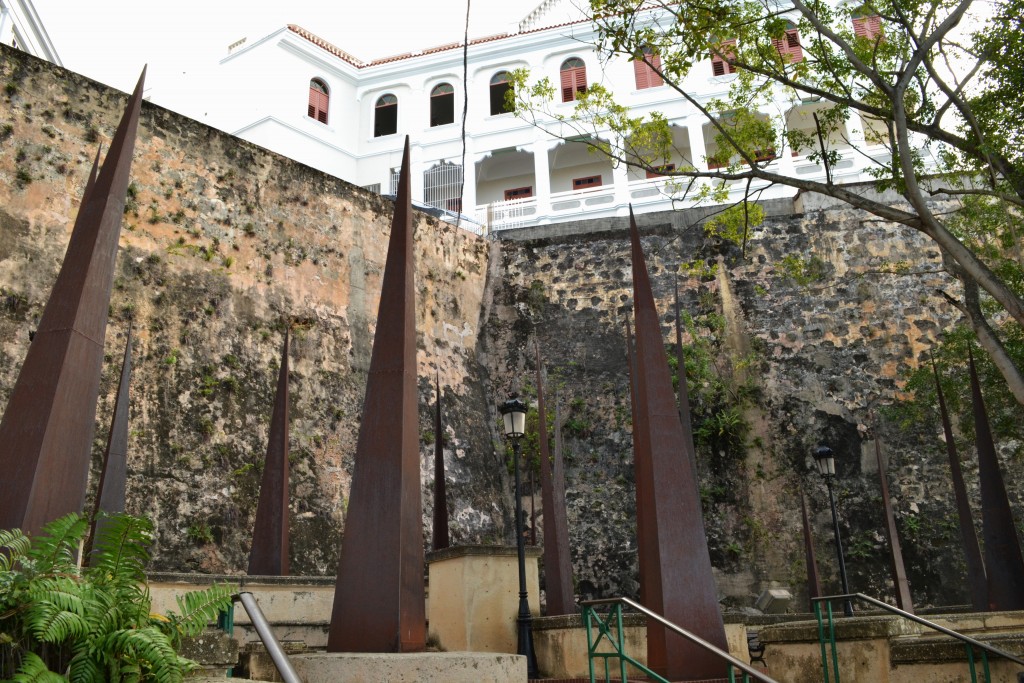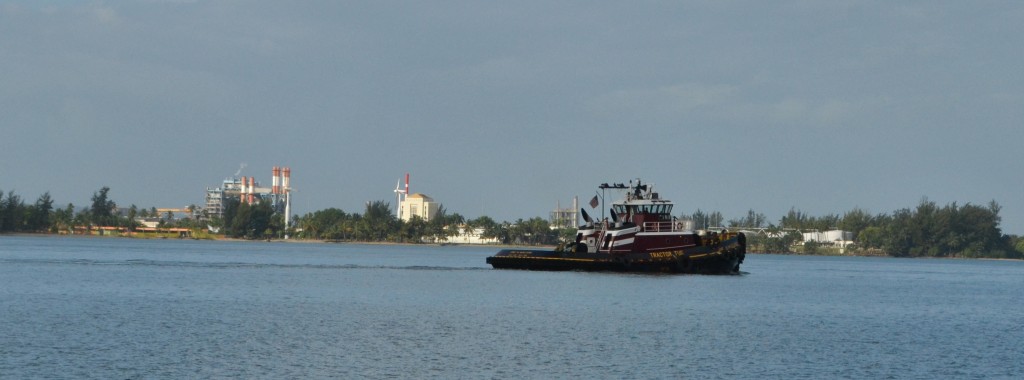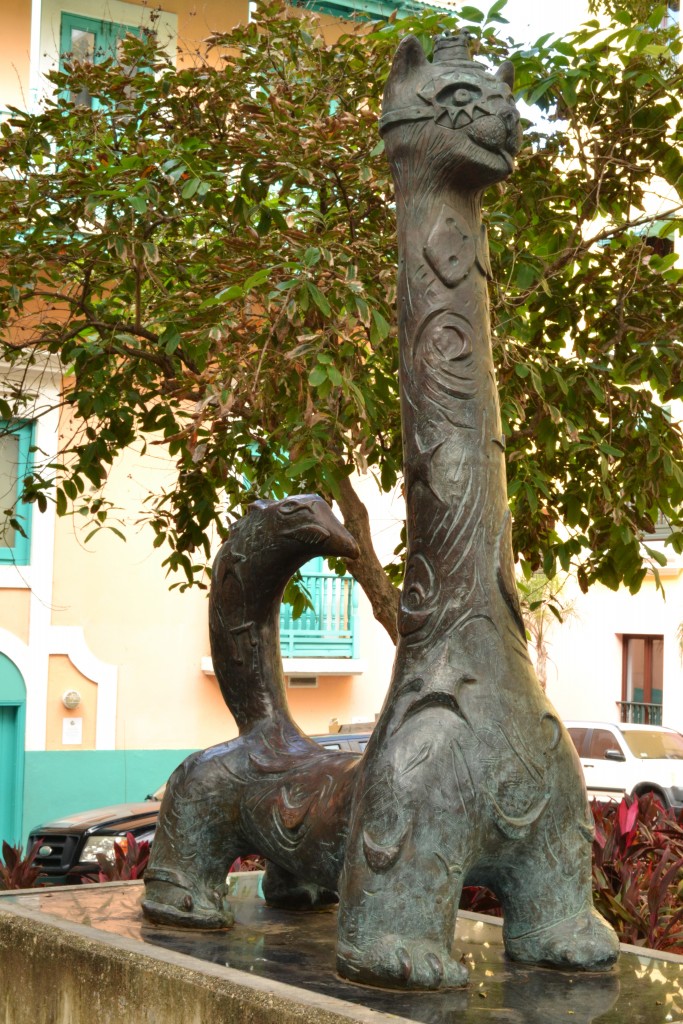, 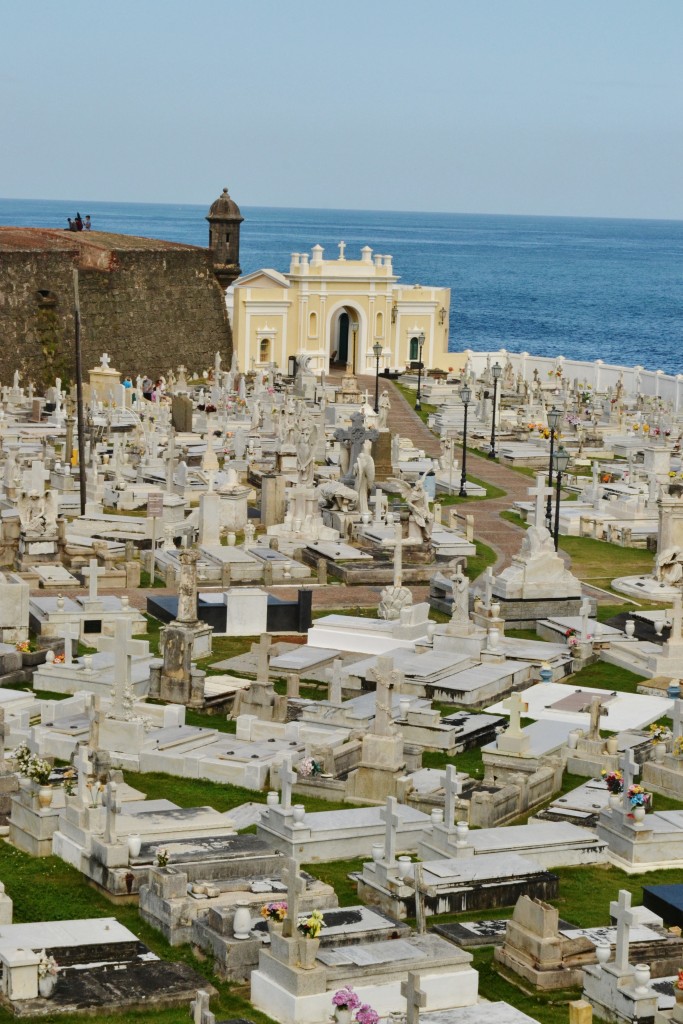
I picked up a couple of bottles of water from a nearby refreshment stand to hold me over until lunch. The next stop on my walking tour included the Cementerio de San Juan. Located on the north side of the fort, this beautifully maintained cemetery is the resting place of the island’s earliest settlers. Behind me on the opposite side of the fort, was the bright purple Galeria Nacional (National Gallery). Once a Dominical convent, the museum houses Puerto Rican artwork spanning over the last few centuries. In addition to hosting various exhibits, the works of famous Puerto Rican artists such as Jose Campeche and Francisco Oller are on permanent display.
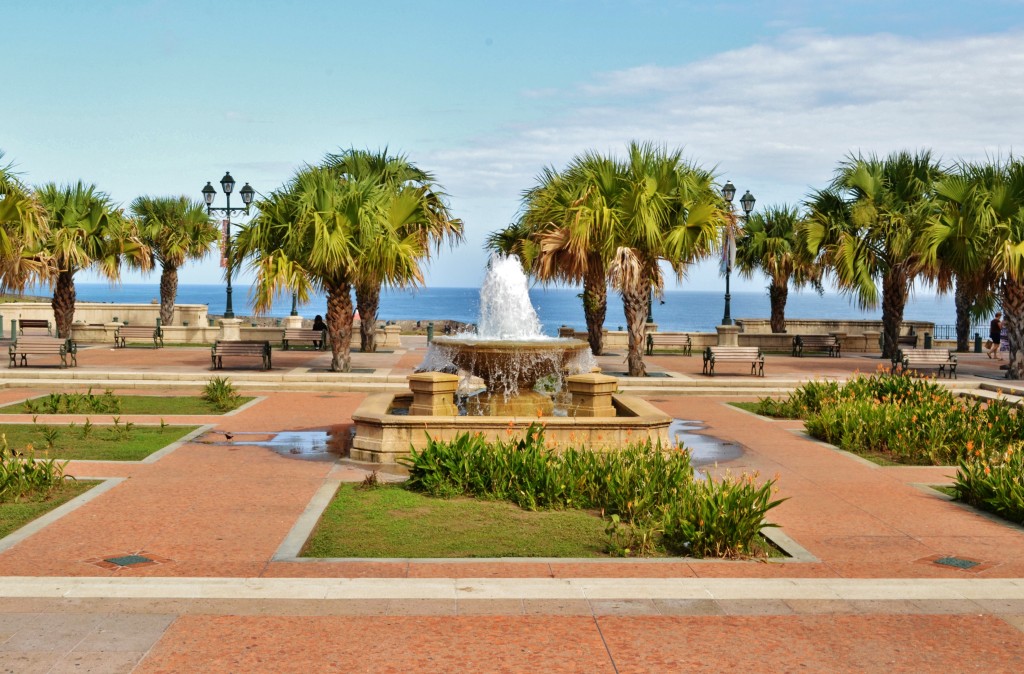
A beautiful park sits across El Morro with its central fountain and sculpture known as the Plaza de Ballaja. The bronze statue of three figures entwined (two men and one woman), represents Puerto Rico’s past, present and future.
Passing the square is the Museo de las Americas. Built in 1854, it served as a military barracks with officer’s quarters, warehouses, prison cells and stables. The cuartel, with its balconies and arches, stands three stories and surrounds a courtyard with large gates at each end. The museum on the second floor houses three permanent exhibits as well as rotating displays throughout the year.
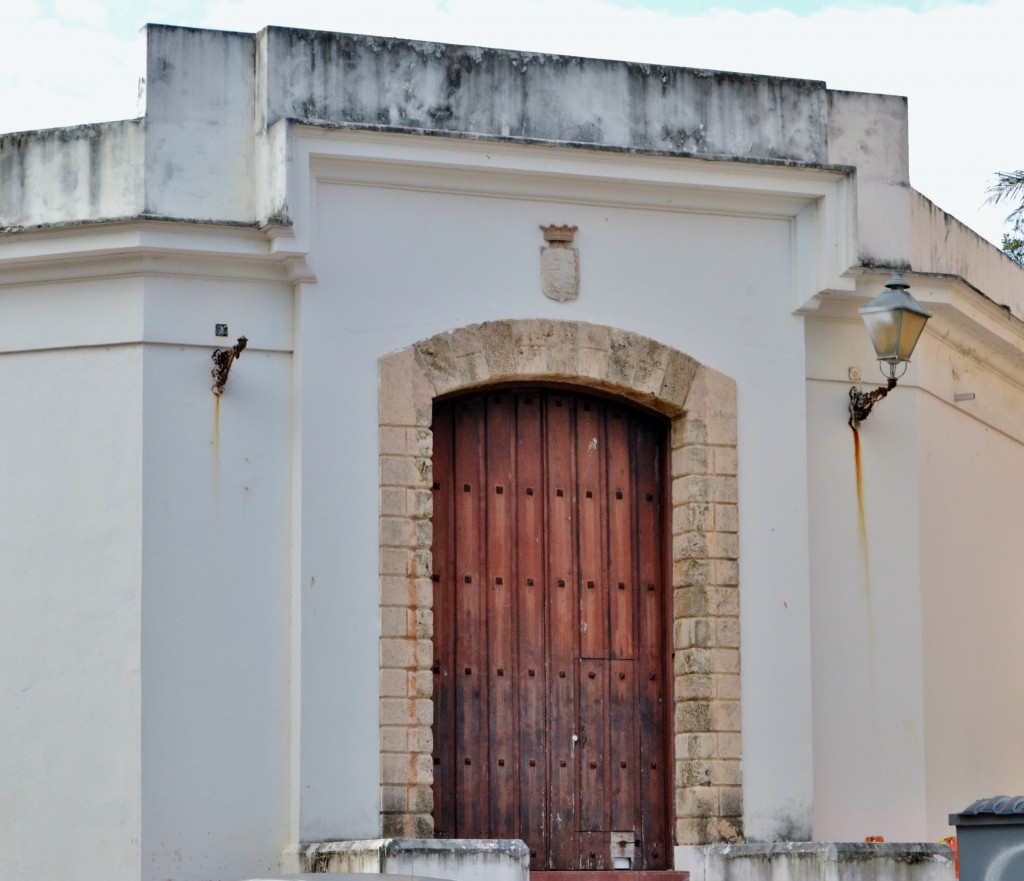
At the end of San Sebastian Street stood Museo Casa Blanca to my right. Although the building was closed, there were informational placards that explained that this home was built for Puerto Rico’s first governor Juan Ponce de Leon (and founder of the Fountain of Youth) in 1524. Unfortunately, de Leon had died before it was completed. With the death of de Leon, the home was passed down to his family who lived here for over 250 years until it became a military base in 1966. The Casa Blanca opened to the public as an historical museum with artifacts spanning from the 16th to 20th centuries. Visitors can stroll the Alhambra-style courtyard with several fountains and gaze out into the ocean from its balconies.
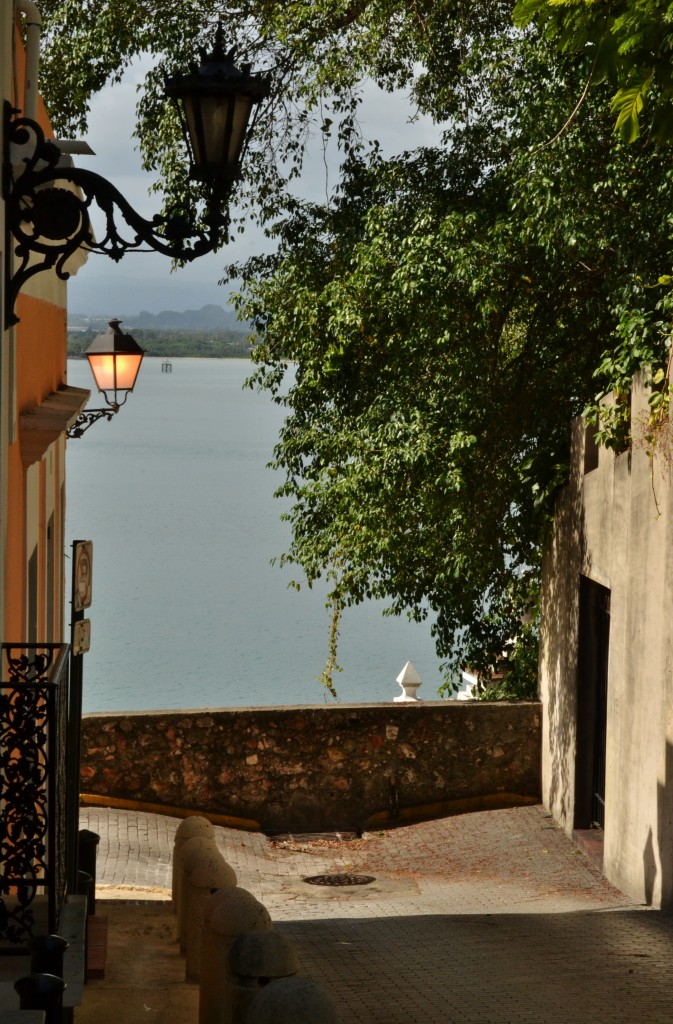
I passed through Calle Sol with its colorful houses and cobblestone streets and realized the road had ended. I just happened to notice a walkway to my left sloping towards the ocean where I found another dead end with spectacular views. Making a left, I soon realized I was walking along the top of the fort.
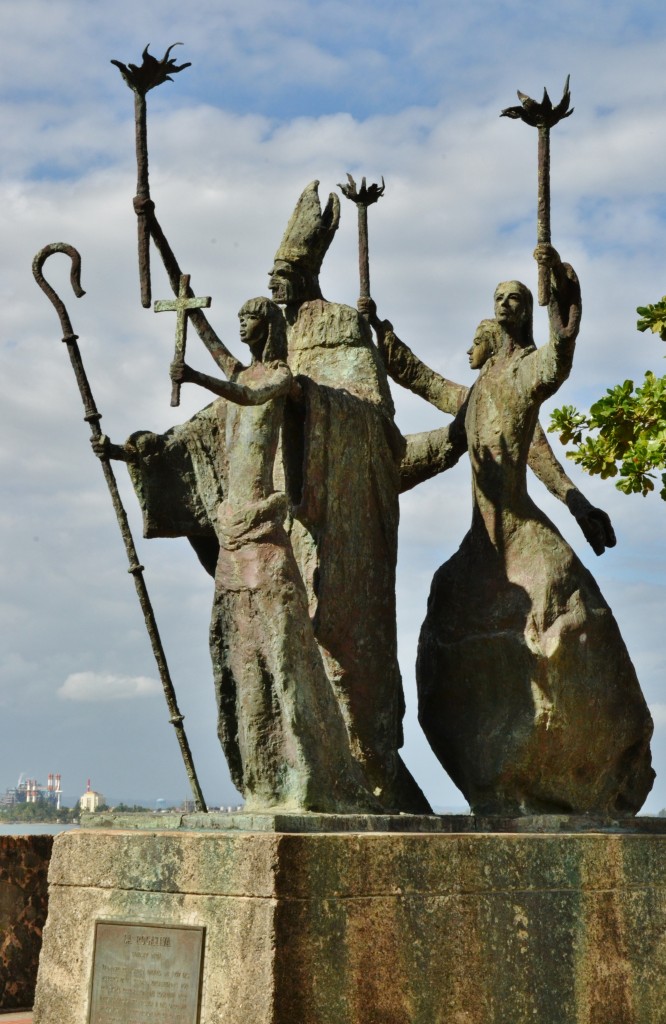
I soon reached the La Rogativa, a statue commemorating an important victory for San Juan against a group of British invaders. The four figures include the bishop of San Juan and three women carrying torches. Legend claims that when British Lieutenant Abercromby was preparing to attack the city in 1797, the women crossed through the plaza with candles, which duped the lieutenant into thinking that they were outnumbered and Abercromby withdrew his fleet. The women were credited for having saved the city.
My stroll continued through Cristo Street, known for its shops. At the end of the street is the Governor’s Residence, La Fortaleza, known as the El Palacio de Santa Catalina. Originally built as a fortress, it was later remodeled and has been the home of San Juan’s governor for over 300 years. Guarded by iron gates, this gorgeous mansion was completed in 1533.
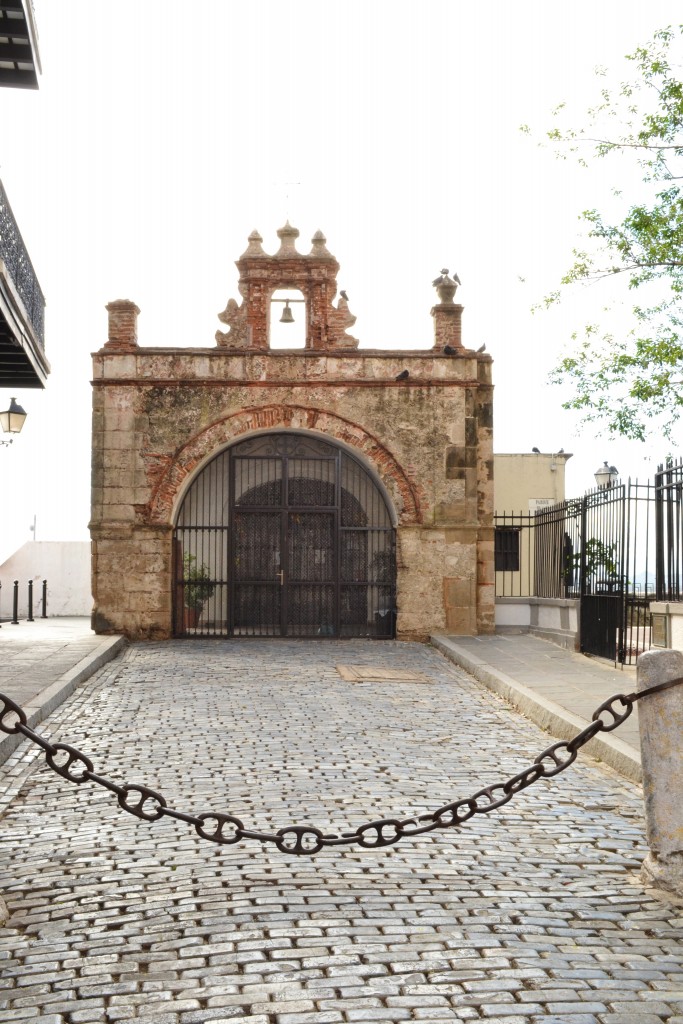
Down Cristo Street, I found the Capilla del Cristo, the Chapel of Christ. Visiting the church, I wanted to learn more about the little chapel and the “miraculous happening [that] took place at this site”.
Inside, the altar is made of thousands of silver “promesas”. Promesas, translated as promises, are offerings that are given in hopes that a miracle will happen. Legend states that a father built the chapel to God to thank Him for saving his son who had survived an unusual accident when he and his horse fell over the wall.
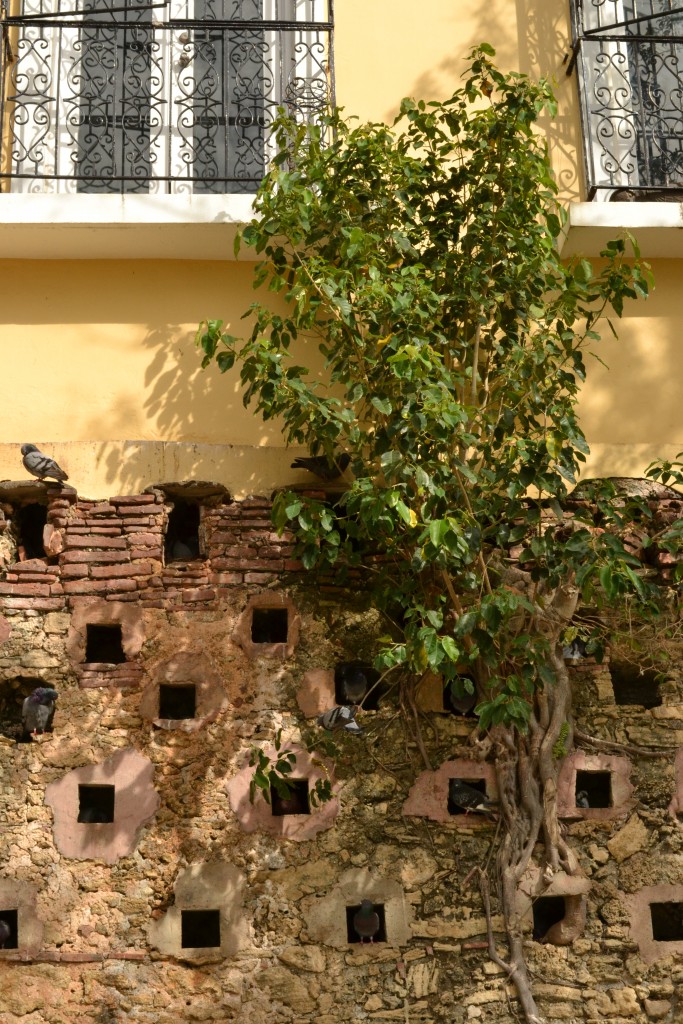
Next to the church is the Parque de las Palomas, the Pigeon Park, which was created to protect the pigeon population in San Juan. There are small niches carved out of the rocky wall so that the pigeons can nest here (condos for pigeons…and look at their scenic view of Bahia de San Juan).
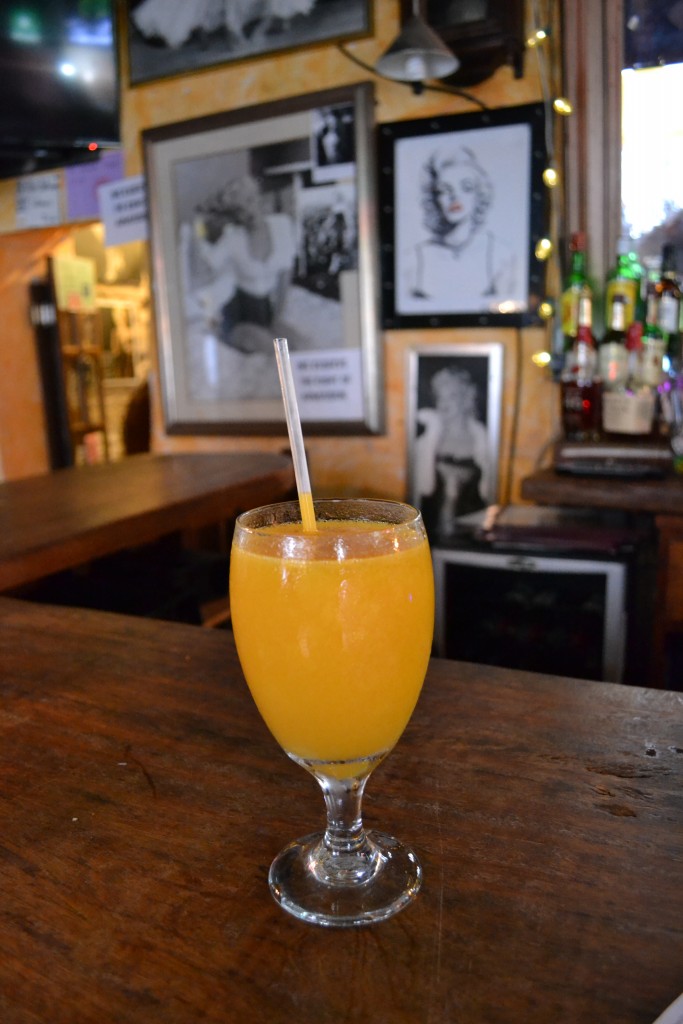
I was near my hotel so I found a small bar on my way called Marilyn’s Place. An homage to actress Marilyn Monroe, I took a seat inside and ordered the mango daiquiri. With limited seating outdoors, I settled for a comfortable seat at the bar, surrounded by Marilyn memorabilia. My appetite was beginning to grow and I could not stop thinking about the mofongo. After a couple of drinks, I decided to return to Fortaleza Street where there were several more restaurant options from which I could choose.
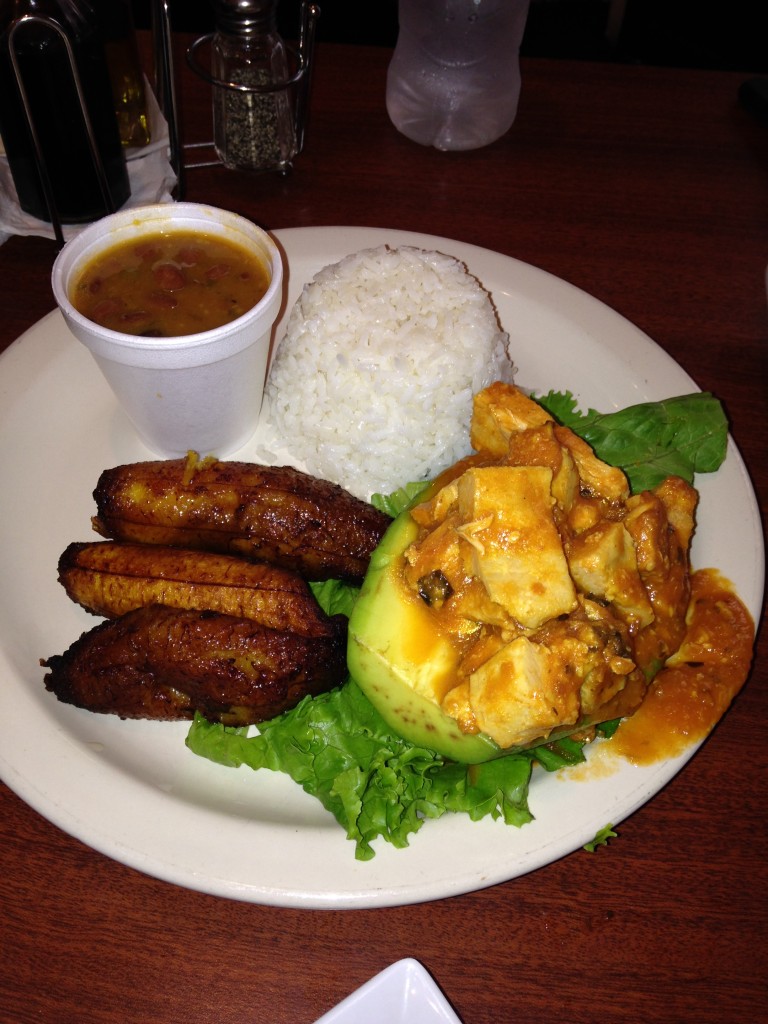
I found another location to try the Mofongo (my new food obsession) called the Café El Punto Restaurant. On the menu, the mofongo comes with a side of avocado, served with beans, rice and cooked plantains. To start, I ordered the caprese salad appetizer.
It was a busy day before I boarded the cruise ship. I was ready to check out of the hotel and and hauled my luggage down to the pier. I noted that I would take a taxi after the cruise ended to avoid rolling my bag across the cobblestone.
It was so nice to unload my belongings and relax aboard the Carnival Liberty, watching the ship pull away from the shore.
If you have been to San Juan, Puerto Rico, what has been you most memorable moment? If you are planning to visit the city, what would you want to see or do? I would love to hear from you if you would kindly leave a message in the comments section below! Many thanks for reading about my time in San Juan, Puerto Rico and wishing you many Happy Travels!
What to See and What to Do:
Castillo San Felipe del Morro
Calle Norzagaray
San Juan, Puerto Rico, 00901
Telephone: 787 729 6960
- Admission Fee: $7 which includes the Castillo San Felipe del Morro and Castillo San Cristobal and 24 hours are provided to visit both forts
- Hours: Open daily from 9AM to 6PM. Closed on Thanksgiving Day, Christmas Day and New Year’s Day.
- Amenities: Gift shop and restrooms
- Scenic Views: Gorgeous views from the fort include the harbor and the cemetery as well as the shoreline.
- Length of Visit: 2 – 3 hours
- Tips for Your Visit: There are several iguanas and feral cats that roam the premises. Wear comfortable shoes, sunscreen and bring plenty of water. (Carts outside sell water). Don’t miss the Dungeon at Castillo San Cristobel!
Cementerio Santa Maria Magdalena de Pazzis
Near the Castillo San Felipe del Morro Fort
- Open 24/7; Free Admission
Galeria Nacional
Calle Del Cristo
San Juan, Puerto Rico 00901
Telephone: 787 724 0700
At the time of this posting, the museum had closed.
Casa Blanca
1 Calle San Sebastian
San Juan, Puerto Rico, 00926
Telephone: 787 725 1454
- Admission Fee: $5 for the tour and a visit of the house; $3 for seniors, students and children). The gardens are free to explore.
- Hours: Open Tuesday through Sunday from 9AM to Noon, reopening from 1PM to 4PM. The gardens are opened daily from 9AM to 4PM.
- Amenities: Wedding venue
- Scenic Views: The beauty of the gardens is quite scenic. Visit the living room for gorgeous views of the ocean from its balconies.
- Length of Visit: 1 – 2 hours
- Tips for Your Visit: Guided tours are offered on occasion and are not consistently scheduled. You may want to call ahead to inquire about a guided tour. The home may be closed on the weekends if a wedding is scheduled.
Chapel of Christ the Savior
151 Calle del Cristo
San Juan, Puerto Rico, 00902
Telephone: 787 722 0861
- Admission Fee: Free, donations welcome
- Hours: The hours of operation are random, yet you can look inside of the gate.
- Scenic Views: Next to the cathedral are gorgeous views of the coast
- Length of Visit: Less than 1 hour
- Tips for Your Visit: Next to the cathedral is a home for pigeons, so beware of them flying above you!
Where to Stay:
Hotel Plaza de Armas
San Jose Street 202
Old San Juan, Puerto Rico 00901
Phone: 866 599 6674
Amenities: Non-smoking, free continental breakfast, WiFi, refrigerator and microwave; there is a free trolley nearby at Stop #8
*Hotel was prepaid costing $150 per night. We arranged for a queen sized bed, room without a window, non-smoking and guaranteed late arrival.
Where to Eat:
Café Colao
Calle Marina, San Juan, Puerto Rico, 00901
Phone: 787 725 4139
Cute little coffee shop down by the Port of Puerto Rico
What to Eat:
- MOFONGO! This is absolutely my favorite dish in San Juan. Mashed fried plantains are smothered with meat and/or vegetables.
- Alcappurias are similar to fritters filled with crab, meat or lobster and dipped in a batter made from green bananas.
- Arepas de Coco is a bread made from coconut flour stuffed with meat, seafood or vegetables.
- Chicharrones de Pollo are usually served as a side dish to mofongo, these tasty pieces of chicken are seasoned with garlic, oregano and achiote.
- Chilo Frito is a fried red snapper served with fried plantains or french fries on the side.
- Lechon is a suckling pig cooked whole and prepared juicy on the inside and crispy on the outside.
- Pastelon: San Juan’s answer to lasagna made with plantains instead of pasta
- The Pina Colada was invented at Barrachina in Old San Juan.
Where to Drink:
Marilyn’s Place
100 Calle San Francisco
San Juan, Puerto Rico, 00901
What to Read:
- The Rum Diary by Hunter S. Thompson
- The House on the Lagoon by Rosario Ferre
- Simone by Eduardo Lalo
- Mundo Cruel by Luis Negron
- La Llamarada by Enrique Laguerre
- Song of the Simple Truth by Julia de Burgos
Photo Guide for San Juan, Puerto Rico
- La Perla in Old San Juan for its colorful umbrellas
- The cobblestone streets and colorful buildings of Old San Juan
- The Forts in Old San Juan
Disclosure: Please refer to our blog disclaimer tab for more information.
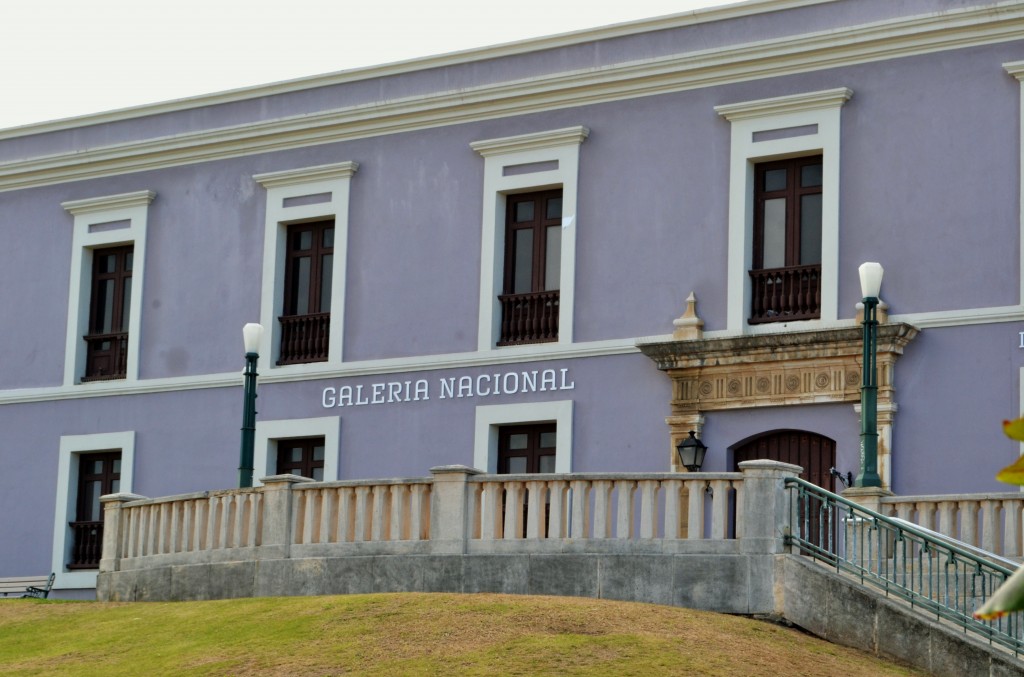
Galeria Nacional
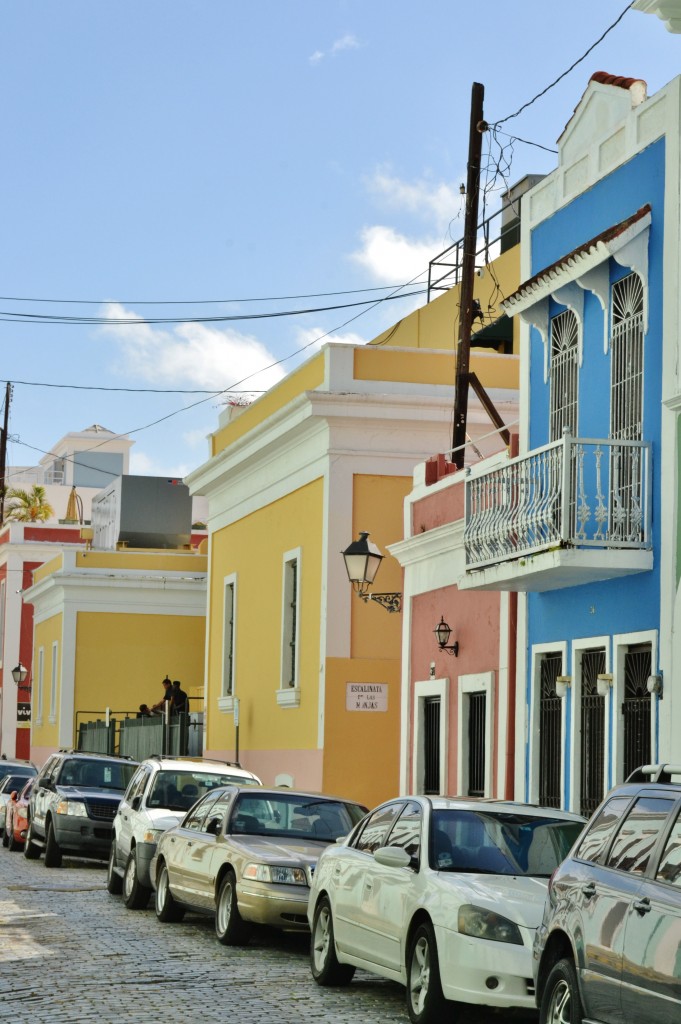
Calle Sol
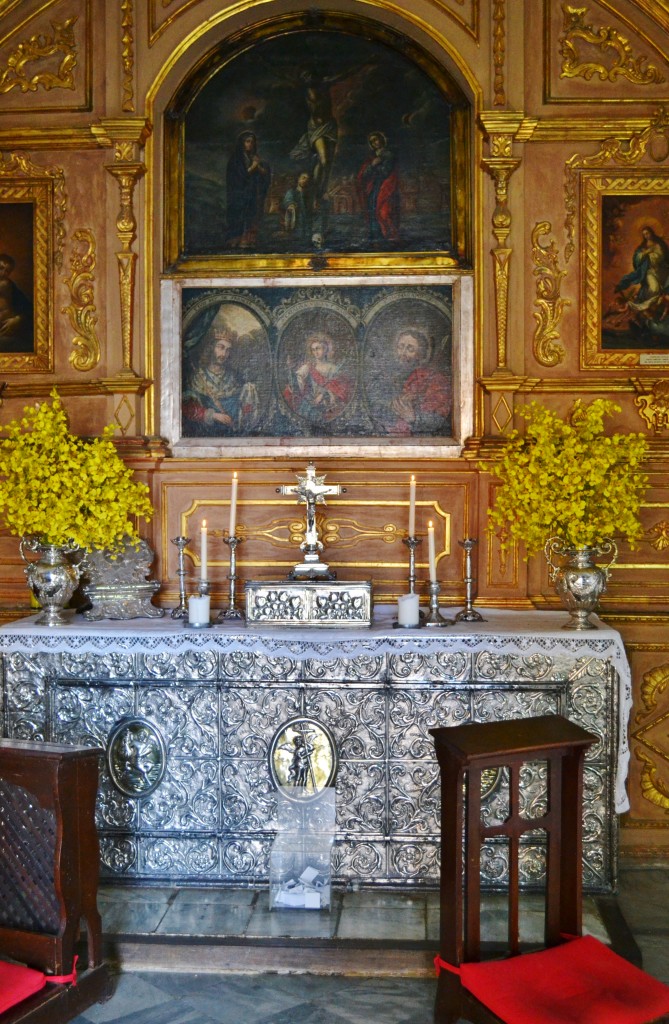
Capilla del Cristo
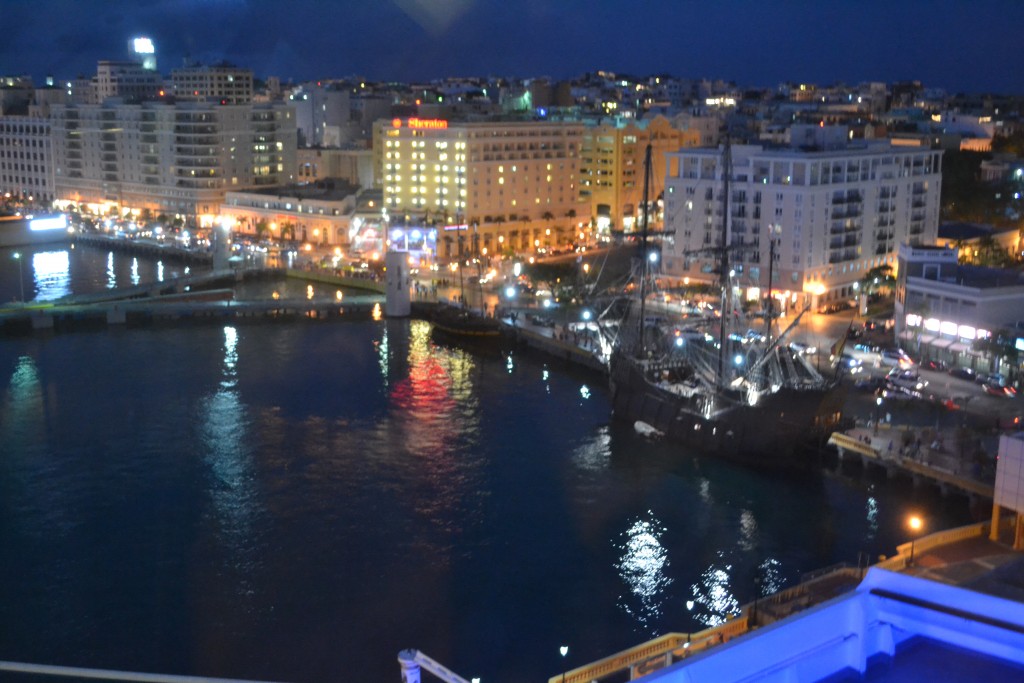
Photos of San Juan from the Carnival Liberty at night
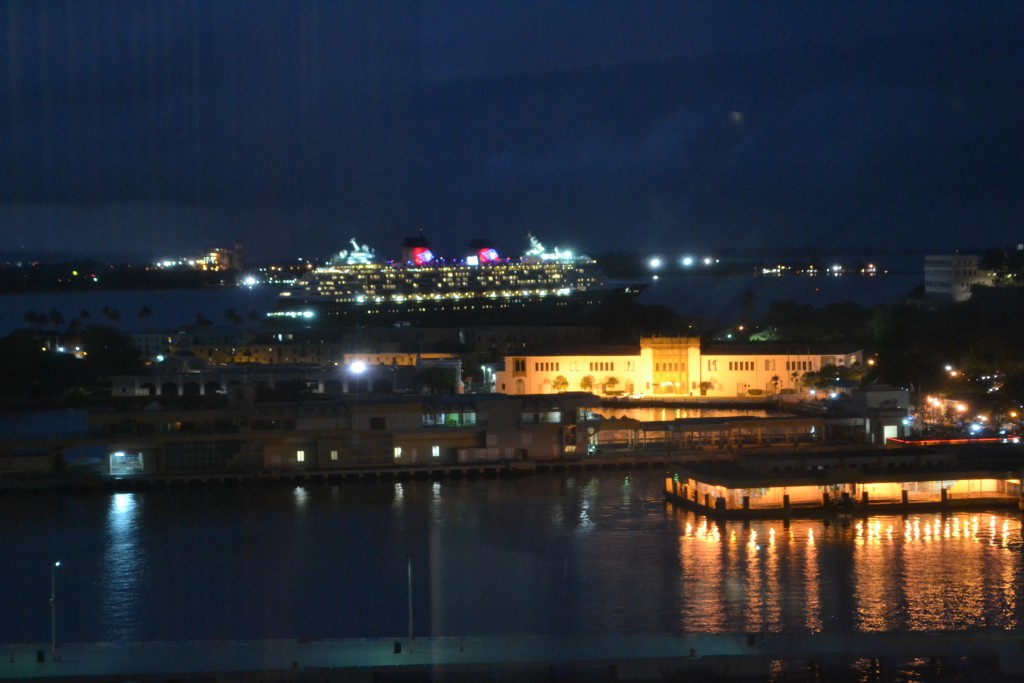
A Disney Cruise Ship Leaving San Juan, Puerto Rico’s Port
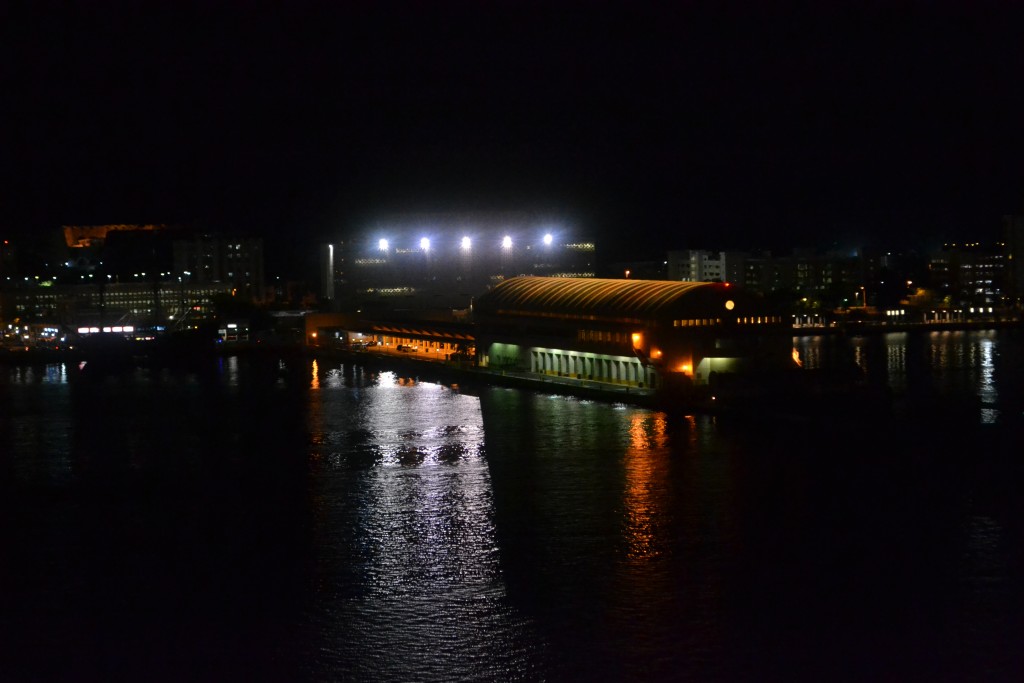
Looking back at Carnival’s Cruise ship Dock in San Juan, PR
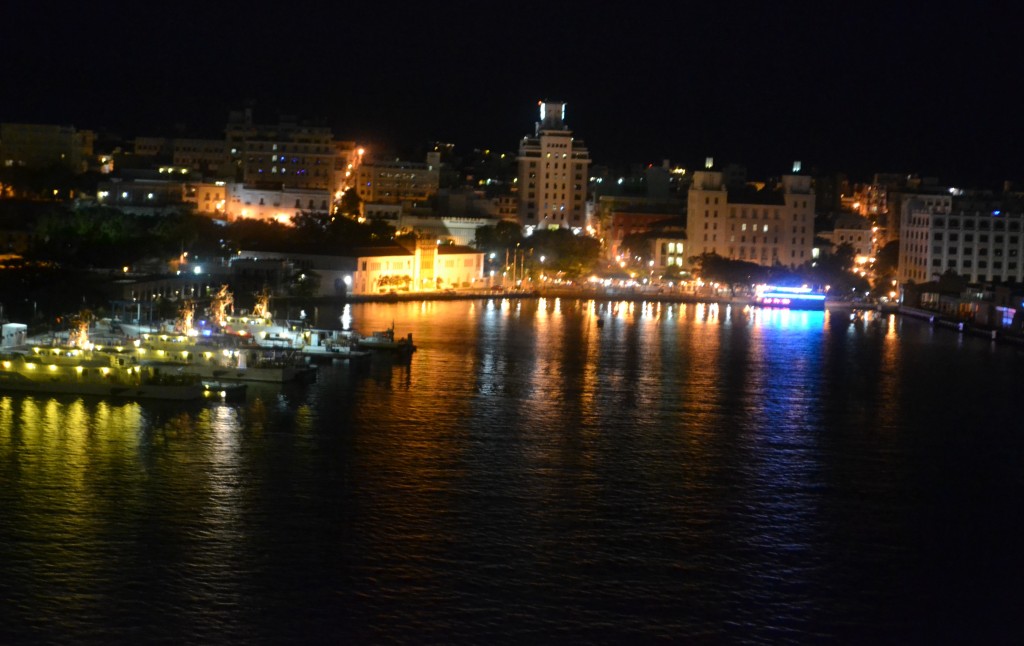
Saying Goodbye to San Juan Puerto Rico
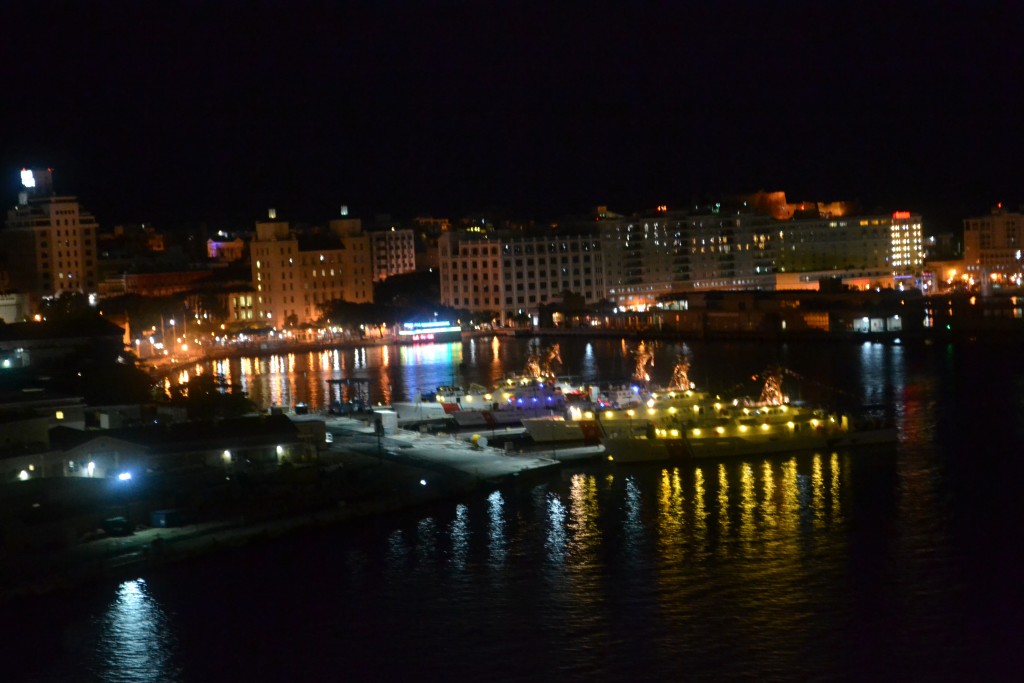
Leaving Behind Old San Juan for the Island of St. Thomas!
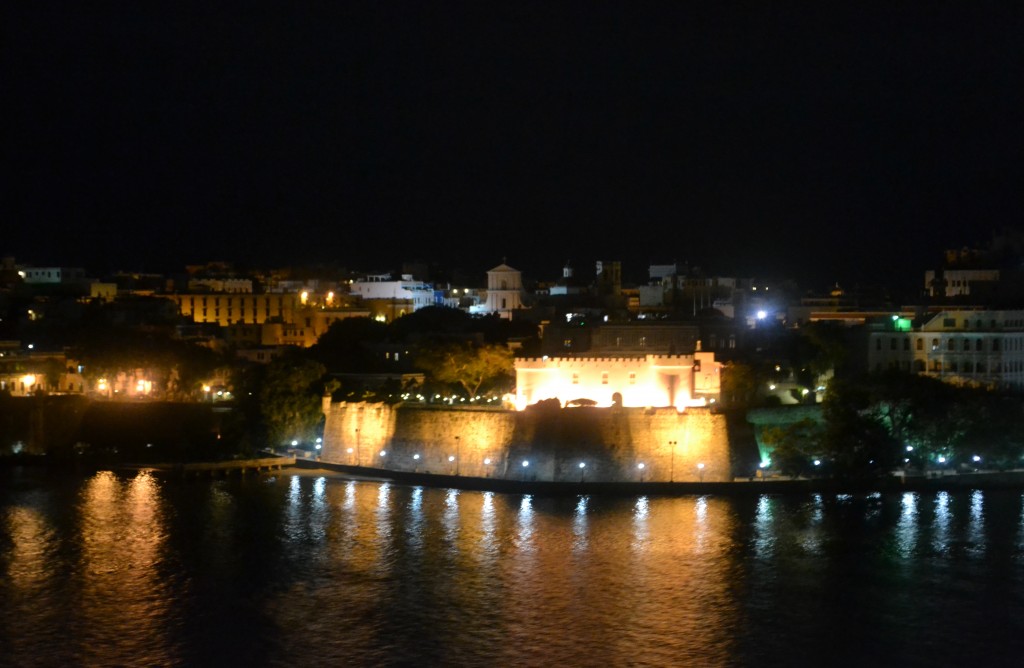
Passing the Walls of the Fort in Old San Juan, PR
